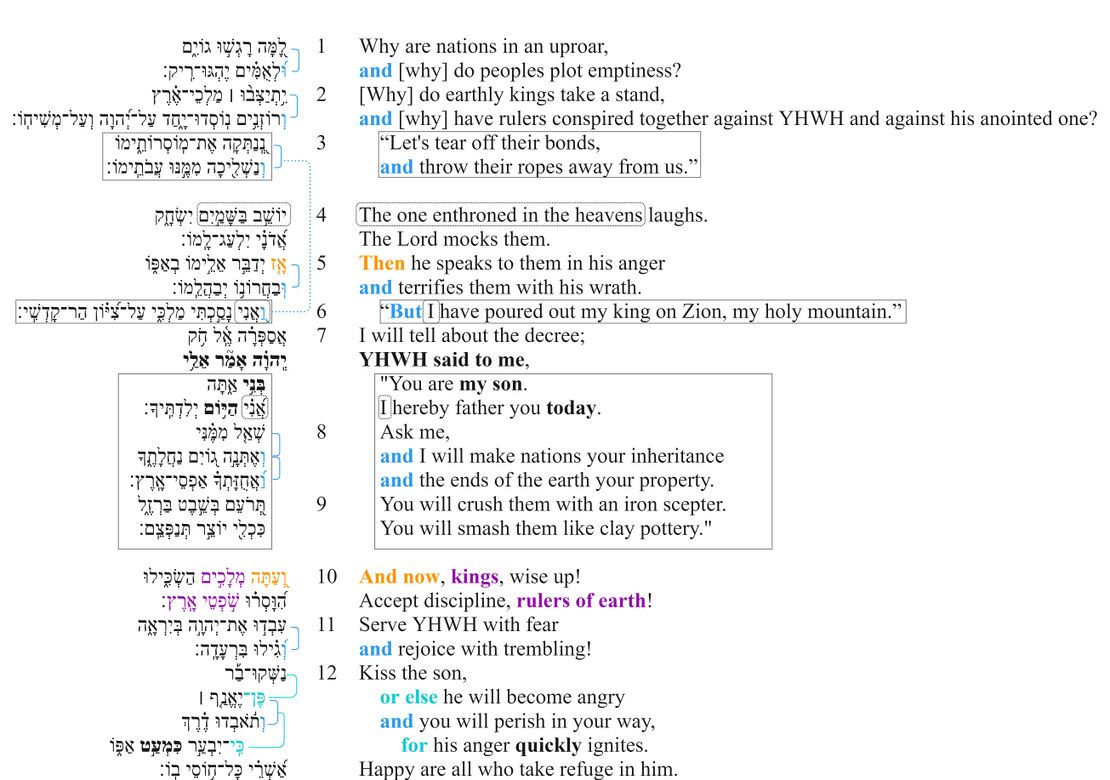Psalm 2 Macrosyntax
From Psalms: Layer by Layer
Psalm 2/Macrosyntax
Choose a PsalmNavigate Psalm 2
Macrosyntax
Macrosyntax Diagram
| Macrosyntax legend | |
|---|---|
| Vocatives | Vocatives are indicated by purple text. |
| Discourse marker | Discourse markers (such as כִּי, הִנֵּה, לָכֵן) are indicated by orange text. |
| The scope governed by the discourse marker is indicated by a dashed orange bracket connecting the discourse marker to its scope. | |
| The preceding discourse grounding the discourse marker is indicated by a solid orange bracket encompassing the relevant clauses. | |
| Subordinating conjunction | The subordinating conjunction is indicated by teal text. |
| Subordination is indicated by a solid teal bracket connecting the subordinating conjunction with the clause to which it is subordinate. | |
| Coordinating conjunction | The coordinating conjunction is indicated by blue text. |
| Coordination is indicated by a solid blue line connecting the coordinating clauses. | |
| Coordination without an explicit conjunction is indicated by a dashed blue line connecting the coordinated clauses. | |
| Marked topic is indicated by a black dashed rounded rectangle around the marked words. | |
| The scope of the activated topic is indicated by a black dashed bracket encompassing the relevant clauses. | |
| Marked focus or thetic sentence | Marked focus (if one constituent) or thetic sentences[1] are indicated by bold text. |
| Frame setters[2] are indicated by a solid gray rounded rectangle around the marked words. | |
| [blank line] | Discourse discontinuity is indicated by a blank line. |
| [indentation] | Syntactic subordination is indicated by indentation. |
| Direct speech is indicated by a solid black rectangle surrounding all relevant clauses. | |
| (text to elucidate the meaning of the macrosyntactic structures) | Within the CBC, any text elucidating the meaning of macrosyntax is indicated in gray text inside parentheses. |
If an emendation or revocalization is preferred, that emendation or revocalization will be marked in the Hebrew text of all the visuals.
| Emendations/Revocalizations legend | |
|---|---|
| *Emended text* | Emended text, text in which the consonants differ from the consonants of the Masoretic text, is indicated by blue asterisks on either side of the emendation. |
| *Revocalized text* | Revocalized text, text in which only the vowels differ from the vowels of the Masoretic text, is indicated by purple asterisks on either side of the revocalization. |
(Click diagram to enlarge)
- vv. 3/4 - The direct speech of v. 3 ends and a new topic is activated in v. 4a.
- vv. 9/10 - YHWH's direct speech of v. 9 ends and v. 10 begins with the discourse marker וְ֭עַתָּה and vocative מְלָכִ֣ים.
- v. 1b - לְאֻמִּים is fronted to create a symmetrical pattern (predicate-subject // subject-predicate) that gives cohesion to v. 1. Note also the patterned repetition of sounds that results: לָמָּה // לְאֻמִּים and רָגְ // גּוּ־רִֽ.
- v. 2b - רוֹזְנִים is fronted to create a symmetrical pattern (predicate-subject // subject-predicate) that gives cohesion to v. 2.
- v. 4a - יוֹשֵׁב בַּשָּׁמַיִם is fronted for topic activation. Even though YHWH is already discourse-present in v. 2 (עַל־יְ֝הוָה), he is introduced here for the first time as the agent of a clause, and so the phrase referring to him is fronted for ease of processing.
- v. 4b - The subject-predicate word order of v. 4b mirrors that of the previous line, creating an ab//ab pattern.
- v. 5b - בַחֲרוֹנוֹ is fronted to create a symmetrical pattern with the previous line: verb-PP // PP-verb.
- v. 6a - וַאֲנִי is fronted for contrastive topic shift. The content of this speech picks up where the previous speech left off (v. 3).
- v. 7bα - יְֽהוָה is fronted to encode a thetic utterance. We would also be forgiven for presuming the agent of אֲסַפְּרָ֗ה in v. 7a was still YHWH, as the speaker of v. 6b, so that YHWH is speaking to me here, provides the necessary orientation for the reader.
- v. 7bβ - The verbless clause בְּנִ֥י אַתָּה is inverted to front בְּנִי as completive focus, filling in the focal information of "You are X [to me]". Alternatively, if the reader has kept up with who is talking (מְשִׁיחוֹ mentioned in v. 2b), perhaps the presupposition would be "You are [only] my human subordinate, sub-ruler and under-shepherd," which would be radically updated by the identification of מְשִׁיחוֹ as בְּנִי, so replacing/scalar focus.
- v. 7c - The double-fronting of אֲ֝נִ֗י הַיּ֥וֹם most naturally reads as topic shifting אֲנִי + focal הַיּוֹם. The adverbial הַיּוֹם is often used with qatal verbs to indicate a performative speech act (Deut 8:19; 30:18; Jer 40:4): "I hereby father you today." Perhaps הַיּוֹם is fronted for corrective focus, to make clear that the fathering is something that happens now ("today") at the moment of speech and not something that happened in the past, e.g., when the king was born. Or maybe it is intensive focus: "this very day..."
- v. 8b - constituents אֲחֻזָּתְךָ֗ אַפְסֵי־אָֽרֶץ inverted to creating symmetry between these and the resultative constituents of the previous clause: ג֭וֹיִם נַחֲלָתֶ֑ךָ וַ֝אֲחֻזָּתְךָ֗ אַפְסֵי־אָֽרֶץ, all bound under one explicit VP.
- v. 9b - כִּכְלִ֖י יוֹצֵ֣ר is fronted to create a symmetrical pattern with the previous line: verb-PP // PP-verb
- v. 12d - post-verbal כִּמְעַ֣ט preceding אַפּ֑וֹ for corrective focus, i.e., you will perish in your conduct because his anger does not burn slowly (and ineffectively with empty promises of wrath), but quickly and easily. This also lends itself to the urgency of the imperatives introduced in vv. 10-12. Furthermore, it also causes אַפּ֑וֹ to be clause final, bringing to mind v. 5a, which has final בְאַפּ֑וֹ, with the result that YHWH and his anointed son's wrath are placed in close comparison.
- v. 10a - The vocative מְלָכִ֣ים occurs before the imperative to identify the addressee.[3]
- v. 10b - The vocative position results in a symmetrical structure with the previous line: vocative-verb // verb-vocative. That the vocative follows the imperative might also be intended to place focus on it.[4]
- v. 5a - The function of the adverb אָז is not entirely clear. It could be a conjunctive adverb (cf. BHRG §40.6(2)) used to connect a sequence of events: "(first) he laughs and mocks; then he speaks...."[5] Alternatively, it could be an adverb of time,[6] referring to the time of the rebellion described in vv. 1-3: "at that time (when they were rebelling), he speaks to them..."[7] It might also connect somehow to וְעַתָּה in v. 10 (cf. e.g., Josh 14:11). We have preferred the first of these options. The effect of using אָז in v. 5 together with yiqtol verbs in vv. 4-5 is to create a dramatic narrative with suspense.
- v. 10a - the combination of both וְ and עַתָּה can rightly be considered one constituent, "often introducing a new subject or section."[8]
- v. 6 - The waw at the beginning of v. 6 functions at the discourse level "to signal text level disjunction or transition."[9] Specifically, in this case, it connects and contrasts YHWH's response to the nations' speech in v. 3. "The function of this type of speech-initial וְ is to mark a dispreferred response."[10]
- v. 12 - The כִּי in v. 12 could be either causal ("for his anger easily ignites")[11] or temporal ("when his anger quickly ignites").[12] If the phrase כִּמְעַט means "quickly/easily" (see note on lexical semantics) then the כִּי is probably causal. The clause is explaining why it is that they will perish in the way if they refuse to submit to the son; it is because his anger ignites (not slowly, but) quickly/easily.
- ↑ When the entire utterance is new/unexpected, it is a thetic sentence (often called "sentence focus"). See our Creator Guidelines for more information on topic and focus.
- ↑ Frame setters are any orientational constituent – typically, but not limited to, spatio-temporal adverbials – function to "limit the applicability of the main predication to a certain restricted domain" and "indicate the general type of information that can be given" in the clause nucleus (Krifka & Musan 2012: 31-32). In previous scholarship, they have been referred to as contextualizing constituents (see, e.g., Buth (1994), “Contextualizing Constituents as Topic, Non-Sequential Background and Dramatic Pause: Hebrew and Aramaic evidence,” in E. Engberg-Pedersen, L. Falster Jakobsen and L. Schack Rasmussen (eds.) Function and expression in Functional Grammar. Berlin: Mouton de Gruyter, 215-231; Buth (2023), “Functional Grammar and the Pragmatics of Information Structure for Biblical Languages,” in W. A. Ross & E. Robar (eds.) Linguistic Theory and the Biblical Text. Cambridge: Open Book Publishers, 67-116), but this has been conflated with the function of topic. In brief: sentence topics, belonging to the clause nucleus, are the entity or event about which the clause provides a new predication; frame setters do not belong in the clause nucleus and rather provide a contextual orientation by which to understand the following clause.
- ↑ Kim 2022, 213-217.
- ↑ Miller 2010, 357.
- ↑ So Baethgen 1904, 5.
- ↑ Cf. BHRG §40.6(1)
- ↑ So Genebrardus and Gejerus, cited in Poole 1678.
- ↑ HALOT, 902; cf. Gen 27:3; Isa 5:3, etc.
- ↑ Bandstra 1990, 52.
- ↑ BHRG §40.23.4.3; see e.g., 1 Kgs 2:21-22.
- ↑ So Peshitta [ܡܛܠ], Targum [מטול]; NIV, NLT, ESV, CSB, LUT, HFA, NGÜ, ELB, EÜ, GNB, ZÜR.
- ↑ So LXX [ὅταν]; KJV, NET.


